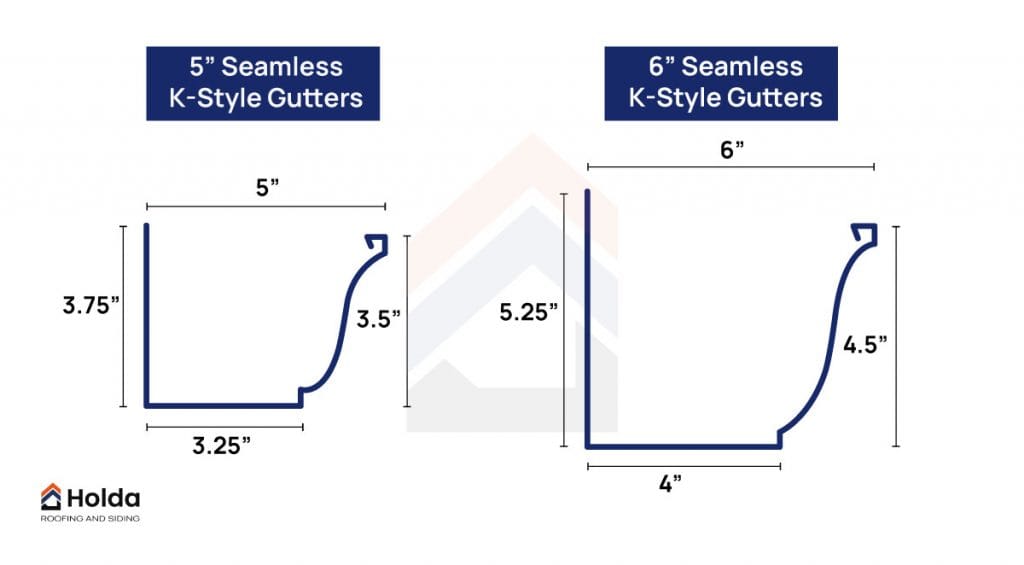IL License Number: 104.017181
IL License Number: 104.017181

Proper gutter sizing is crucial for managing rain effectively, protecting your home from water damage, and extending the life of your roofing, fascia/soffits, and foundation. This guide explains what really matters—capacity, speed, downspouts, materials, measurement, cost—and when to choose standard 5″ gutters versus oversized 6″.
While DIY gutter projects most often involve assembling gutter systems from sections bought at Home Depot or Lowe’s, professional gutter installation is different. We purchase gutter coil and accessories, then load the coils onto our machine in our trailer, either at our shop or the supply house. We then bring these materials to your home and fabricate the seamless gutters on-site, custom-cutting to the exact lengths needed for your house. This can add to both aesthetics and functionality.
Here’s the difference you can picture right away: a 5″ gutter holds about 1.2 gallons of water per foot, while a 6″ gutter holds roughly 2.0 gallons per foot—that’s 67% more capacity. On a 30-foot stretch in a heavy rain, that’s 36 gallons vs. 60 gallons. More capacity means fewer spillovers, less streaking on your siding, and better protection for your landscaping and foundation.
Gutters don’t “waterproof” a roof—roofs are built to shed water. Problems show up when water hits the gutter faster than it can be caught or drained: spills over the front, or ponds in the trough. That’s when you see soffit/fascia rot, siding streaks, landscape washouts, and foundation splash/erosion.

Critical takeaway: Treat gutters as plumbing for rain—catch window + pitch + outlets + downspouts + clean transitions. If any link is undersized or poorly executed, overflow shows up at the ground.
You can “get away with” 5″ in select spots, but 6″ remains the safer, future-proof choice for the whole home—especially if you’ll add guards later or already have steep planes.
A Success Story of Solving Overflow Issues
We recommend that you choose 3×4″ downspouts as a go-to. These downspouts move water out faster (resulting in less backup), look cleaner on most homes, and the upgrade from 2×3″ typically runs ~$50 in materials per job, which is small money for a big improvement.
Smart placement, simple rules:
Fascia boards are commonly 5.25″–7.25″ tall. A 6″ gutter (about 5″ tall) often matches proportions better than a 5″, covers more trim, and boosts curb appeal—especially on newer homes with larger fascias and bolder elevations.


Simple example:
Cost reality:
In this video, we showcase a complete gutter installation project in Barrington Hills, IL, where we upgraded the home’s gutters from 5″ to 6″ oversized gutters with improved pitch and larger downspouts to fix overflow issues. Along with highlighting our expert installation process, the video features a fun moment with a surprise guest—a little turtle making his way to the family’s pool!
Even the right size fails if these basics aren’t done well:
To Keep It Simple: Right size, right pitch, the right number/placement of outlets, and 3×4″ downspouts—miss any one and the system can still overflow.
Even the right size fails if these basics aren’t done well:
If you answer “Yes” to any of the questions below, pick 6″ gutters + 3×4″ downspouts.
If every section is short and low-slope, with no metal roof areas and no gutter guards (i.e. a shed), a 5″ gutter can work.
That said, we still recommend 6″ gutters for extra storm capacity and future-proofing (especially if you might add guards later).
Selecting the right gutter size is essential for protecting your home and keeping water where it belongs—away from your siding, trim, and foundation. If you’d like a professional assessment or a quote tailored to your home, contact us. We’ll review roof pitch, catch areas, aesthetics, and budget, then recommend a system that performs in real weather—not just on paper.
With over twenty years in business and hundreds of satisfied customers, we know what it takes to properly maintain a home. Join the family of satisfied homeowners who trust Holda Construction Roofing and Siding for all their roofing and siding needs.
We look forward to working with you!
Address
317 W Colfax St. Suite 102
Palatine, IL 60067